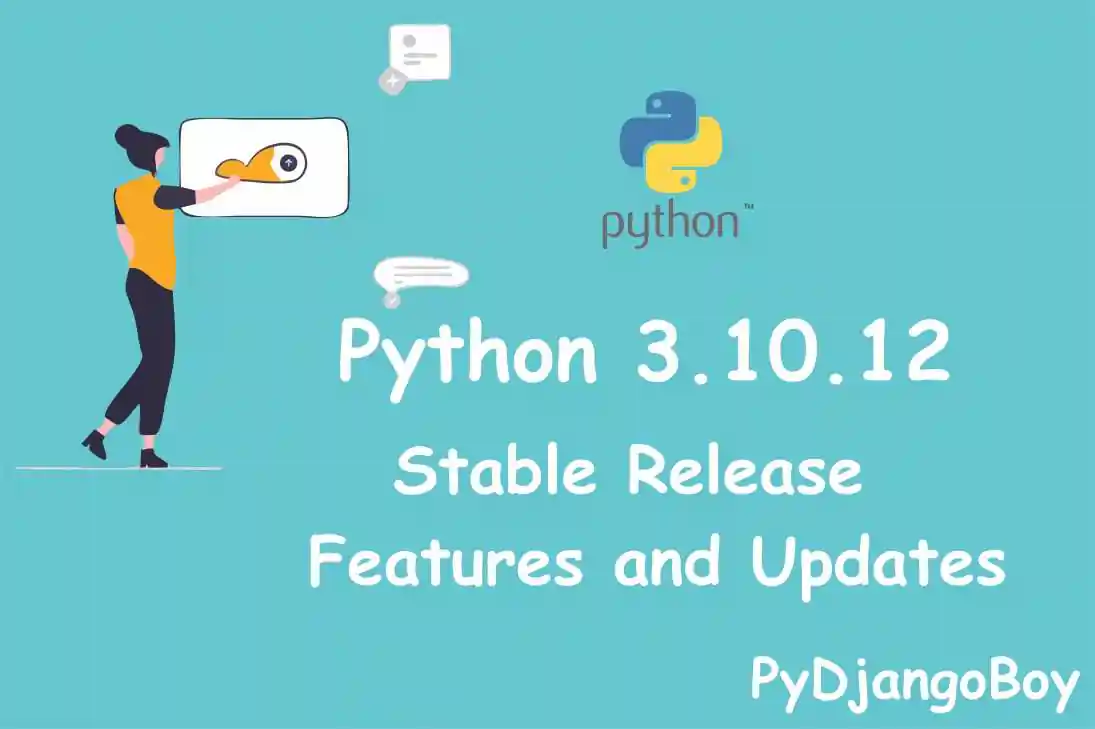Python Interview Decoded Unlocking the Top 50 Questions and Answers for Freshers
This blog post provides a comprehensive guide to the top 50 Python interview questions and answers for freshers. It covers a wide range of topics, including basic Python concepts, object-oriented programming, data structures, algorithms, and more.

Python Interview Decoded: Unlocking the Top 50 Questions and Answers for Freshers
This blog post provides a comprehensive guide to the top 50 Python interview questions and answers for freshers. It covers a wide range of topics, including basic Python concepts, object-oriented programming, data structures, algorithms, and more. Each question is accompanied by a clear explanation and example code to help readers understand the concepts and practice their skills. By reading and practicing with these questions, freshers can gain confidence and prepare effectively for their Python interviews.
Here's an outline of the blog post:
I. Introduction
- Explanation of the purpose of the blog post
- Brief overview of the top 50 Python interview questions and answers
II. Basic Python Concepts
- Data types and operators
- Control structures
- Functions and modules
- Exception handling
III. Object-Oriented Programming
- Classes and objects
- Inheritance and polymorphism
- Encapsulation and abstraction
IV. Data Structures and Algorithms
- Lists, tuples, and dictionaries
- Sorting and searching algorithms
- Recursion and dynamic programming
- Big O notation
V. Advanced Python Concepts
- Decorators
- Generators and iterators
- Concurrency and parallelism
- Regular expressions
VI. Conclusion
- Summary of the top 50 Python interview questions and answers
- Importance of practicing with these questions to prepare for Python interviews
Get ready to laugh and learn with these Python quotes!
"Python is the second best thing to happen to me, Django being the first. Well, maybe PyDjangoBoy is a close third." 😄
here are the top 50 Python interview questions for fresher with proper answers and explanations along with example code and output:
1. What is Python?
Python is a high-level, interpreted, and object-oriented programming language. It was first released in 1991 and has become popular due to its simplicity, ease of use, and versatility.
2. What are the key features of Python?
Some key features of Python include:
- Easy-to-learn syntax
- Interpreted language
- Object-oriented programming support
- High-level dynamic data types
- Automatic memory management
- Large standard library
- Cross-platform compatibility
3. What is PEP 8?
PEP 8 is a style guide for Python code. It provides guidelines for formatting and writing code that is consistent, readable, and maintainable. Some key guidelines include using 4-space indentation, using descriptive variable names, and limiting line length to 79 characters.
Example code:
# Good example
def calculate_area(base, height):
area = (base * height) / 2
return area
# Bad example
def calc(b, h):
a=(b*h)/2
return a
4. What is a tuple in Python?
A tuple is an immutable sequence of elements, typically used to group related data. Tuples are defined using parentheses and can contain any combination of data types.
Example code:
my_tuple = ("apple", 5, True)
print(my_tuple)
Output:
('apple', 5, True)5. What is a list in Python?
A list is a mutable sequence of elements, typically used to group related data. Lists are defined using square brackets and can contain any combination of data types.
Example code:
my_list = ["apple", 5, True]
print(my_list)
Output:
['apple', 5, True]6. What is a dictionary in Python?
A dictionary is an unordered collection of key-value pairs, typically used to store and retrieve data using keys. Dictionaries are defined using curly braces and can contain any combination of data types.
Example code:
my_dict = {"name": "John", "age": 30, "is_student": True}
print(my_dict)
Output:
{'name': 'John', 'age': 30, 'is_student': True}7. What is a set in Python?
A set is an unordered collection of unique elements, typically used to perform mathematical operations such as union, intersection, and difference. Sets are defined using curly braces or the set() function.
Example code:
my_set = {1, 2, 3}
print(my_set)
Output:
{1, 2, 3}8. What is the difference between a list and a tuple in Python?
The main difference between a list and a tuple is that a list is mutable (can be changed) while a tuple is immutable (cannot be changed). Lists are defined using square brackets and tuples are defined using parentheses.
Example code:
# List example
my_list = [1, 2, 3]
my_list[0] = 4
print(my_list)
# Tuple example
my_tuple = (1, 2, 3)
my_tuple[0] = 4
print(my_tuple)
Output:
[4, 2, 3]
TypeError: 'tuple' object does not support item assignment9. What is the difference between a dictionary and a set in Python?
The main difference between a dictionary and a set is that a dictionary stores key-value pairs, while a set stores only unique elements. Dictionaries are defined using curly braces and key-value pairs separated by colons, while sets are defined using curly braces or the set() function.
Example code:
# Dictionary example
my_dict = {"apple": 5, "banana": 3, "orange": 2}
print(my_dict)
# Set example
my_set = {1, 2, 3, 3, 3}
print(my_set)
Output:
{'apple': 5, 'banana': 3, 'orange': 2}
{1, 2, 3}10. What is a module in Python?
A module is a file containing Python definitions and statements. Modules can be used to organize code into logical units and to reuse code across multiple projects. To use a module, it must be imported using the import statement.
Example code:
# Define a module
# file: my_module.py
def greet(name):
print(f"Hello, {name}!")
# Use the module in another file
# file: main.py
import my_module
my_module.greet("John")
Output:
Hello, John!11. What is a package in Python?
A package is a collection of related modules. Packages can be used to organize code into logical units and to reuse code across multiple projects. Packages are typically defined as a directory containing an __init__.py file and one or more modules.
Example code:
my_package/
__init__.py
module1.py
module2.py
12. What is the difference between a module and a package in Python?
A module is a single file containing Python definitions and statements, while a package is a collection of related modules. Modules can be used to organize code into logical units and to reuse code across multiple projects. Packages are typically defined as a directory containing an __init__.py file and one or more modules.
13. What is the difference between range() and xrange() in Python?
In Python 2, range() returns a list of values, while xrange() returns a generator object that generates values on-the-fly. In Python 3, range() behaves like xrange() and returns a generator object that generates values on-the-fly.
Example code:
# Python 2 example
# Using range()
for i in range(5):
print(i)
Output :
0
1
2
3
4
# Using xrange()
for i in xrange(5):
print(i)
Output :
0
1
2
3
4
# Python 3 example
# Using range()
for i in range(5):
print(i)
Output :
0
1
2
3
414. What is a generator in Python?
A generator is a type of iterator that generates values on-the-fly. Generators can be created using a function that uses the yield keyword to return values one at a time.
Example code:
def my_generator():
yield 1
yield 2
yield 3
# Using the generator
gen = my_generator()
print(next(gen))
print(next(gen))
print(next(gen))
Output:
1
2
315. What is a decorator in Python?
A decorator is a function that takes another function as input and returns a modified version of the function. Decorators are used to modify the behavior of functions without changing their source code.
Example code:
# Define a decorator function
def my_decorator(func):
def wrapper():
print("Before function call")
func()
print("After function call")
return wrapper
# Use the decorator to modify a function
@my_decorator
def my_function():
print("Function call")
# Call the modified function
my_function()
Output:
Before function call
Function call
After function call16. What is the difference between a local variable and a global variable in Python?
A local variable is a variable defined inside a function and is only accessible within that function. A global variable is a variable defined outside of any function and is accessible throughout the entire program.
Example code:
# Global variable
my_global_variable = 10
# Function with local variable
def my_function():
my_local_variable = 5
print(my_local_variable)
# Accessing the global variable
print(my_global_variable)
# Calling the function
my_function()
# Trying to access the local variable outside the function
print(my_local_variable)
Output:
10
5
NameError: name 'my_local_variable' is not defined17. What is a lambda function in Python?
A lambda function is a small anonymous function that can have any number of arguments but can only have one expression. Lambda functions are often used as an inline function within other functions.
Example code:
# Define a lambda function
my_lambda_function = lambda x: x * 2
# Use the lambda function
print(my_lambda_function(5))
Output:
1018. What is a closure in Python?
A closure is a function object that remembers values in the enclosing scope even if they are not present in memory. Closures can be used to create function factories or to create functions with a fixed set of arguments.
# Define a closure
def outer_function(x):
def inner_function(y):
return x + y
return inner_function
# Use the closure
my_closure = outer_function(5)
print(my_closure(3))
Output:
819. What is the difference between is and == in Python?
The is operator tests if two variables refer to the same object, while the == operator tests if two variables have the same value.
Example code:
# Using the is operator
a = [1, 2, 3]
b = a
print(a is b)
# Using the == operator
a = [1, 2, 3]
b = [1, 2, 3]
print(a == b)
Output:
True
True20. What is a namespace in Python?
A namespace is a collection of names and their corresponding objects. Namespaces are used to avoid naming conflicts and to organize code into logical units. There are several types of namespaces in Python, including the built-in namespace, the global namespace, and the local namespace.
Example code:
# Using the built-in namespace
print(abs(-5))
# Using the global namespace
my_global_variable = 10
def my_function():
print(my_global_variable)
my_function()
# Using the local namespace
def my_function():
my_local_variable = 5
print(my_local_variable)
my_function()
Output:
5
10
521. What is the difference between append() and extend() in Python?
The append() method is used to add a single element to the end of a list, while the extend() method is used to add multiple elements to the end of a list.
Example code:
# Using the append() method
my_list = [1, 2, 3]
my_list.append(4)
print(my_list)
# Using the extend() method
my_list = [1, 2, 3]
my_list.extend([4, 5, 6])
print(my_list)
Output:
[1, 2, 3, 4]
[1, 2, 3, 4, 5, 6]22. What is the difference between a tuple and a list in Python?
A tuple is an immutable sequence of values, while a list is a mutable sequence of values. Tuples are often used to represent fixed collections of related items, while lists are often used to represent variable-length collections of related items.
Example code:
23. What is a generator in Python?
A generator is a function that returns an iterator. Generators are used to create sequences of values that are computed on-the-fly, rather than all at once. This allows for the creation of sequences that would be too large to store in memory all at once.
Example code:
# Define a generator function
def my_generator():
for i in range(5):
yield i
# Use the generator
for value in my_generator():
print(value)
Output:
0
1
2
3
424. What is the __init__() method in Python?
The __init__() method is a special method in Python that is used to initialize an object when it is created. The __init__() method is called automatically when an object is created from a class.
Example code:
# Define a class with an __init__() method
class MyClass:
def __init__(self, x):
self.x = x
# Create an object of the class
my_object = MyClass(5)
# Access the attribute of the object
print(my_object.x)
Output:
525. What is the difference between a shallow copy and a deep copy in Python?
A shallow copy creates a new object that references the same memory as the original object, while a deep copy creates a new object with a new memory address that contains copies of the original object's data.
Example code:
# Using a shallow copy
my_list = [[1, 2], [3, 4]]
my_copy = my_list.copy()
my_list[0][0] = 5
print(my_list)
print(my_copy)
# Using a deep copy
import copy
my_list = [[1, 2], [3, 4]]
my_copy = copy.deepcopy(my_list)
my_list[0][0] = 5
print(my_list)
print(my_copy)
Output :
[[5, 2], [3, 4]]
[[5, 2], [3, 4]]
[[5, 2], [3, 4]]
[[1, 2], [3, 4]]26. What is a lambda function in Python?
A lambda function is an anonymous function that is defined without a name. Lambda functions can take any number of arguments, but can only have one expression.
Example code:
# Using a lambda function
my_function = lambda x: x + 1
print(my_function(2))
Output:
327. What is a decorator in Python?
A decorator is a function that takes another function as input and returns a new function as output. Decorators are used to modify the behavior of a function without modifying the function itself.
Example code:
# Define a decorator
def my_decorator(function):
def wrapper():
print("Before the function is called.")
function()
print("After the function is called.")
return wrapper
# Use the decorator
@my_decorator
def my_function():
print("The function is called.")
my_function()
Output:
Before the function is called.
The function is called.
After the function is called.28. What is a set in Python?
A set is an unordered collection of unique elements. Sets are used to perform mathematical operations such as union, intersection, and difference.
Example code:
# Define a set
my_set = {1, 2, 3, 4, 5}
# Add an element to the set
my_set.add(6)
# Remove an element from the set
my_set.remove(1)
# Perform a union operation
my_other_set = {4, 5, 6, 7, 8}
union = my_set.union(my_other_set)
# Perform an intersection operation
intersection = my_set.intersection(my_other_set)
# Perform a difference operation
difference = my_set.difference(my_other_set)
# Print the results
print(my_set)
print(union)
print(intersection)
print(difference)
Output:
{2, 3, 4, 5, 6}
{2, 3, 4, 5, 6, 7, 8}
{4, 5, 6}
{2, 3}29. What is a dictionary in Python?
A dictionary is an unordered collection of key-value pairs. Dictionaries are used to represent mappings between keys and values.
Example code:
# Define a dictionary
my_dict = {"key1": "value1", "key2": "value2"}
# Access a value using a key
print(my_dict["key1"])
# Add a key-value pair to the dictionary
my_dict["key3"] = "value3"
# Remove a key-value pair from the dictionary
del my_dict["key2"]
# Print the keys and values of the dictionary
for key, value in my_dict.items():
print(key, value)
Output:
value1
key1 value1
key3 value330. What is a module in Python?
A module is a file that contains Python code. Modules are used to organize Python code into reusable components.
Example code:
# Import a module
import math
# Use a function from the module
print(math.sqrt(25))
Output:
5.031. What is a package in Python?
A package is a collection of related modules that are organized into a directory hierarchy. Packages are used to organize larger Python projects.
Example code:
# Directory hierarchy of a package
my_package/
__init__.py
module1.py
module2.py
To use a module from a package, you can import it using dot notation:
# Import a module from a package
import my_package.module1
# Use a function from the module
my_package.module1.my_function()
32. What is pip in Python?
pip is a package manager for Python. It is used to install and manage Python packages and their dependencies.
Example code:
# Install a package using pip
pip install pandas
# Import the package
import pandas
33. What is a virtual environment in Python?
A virtual environment is an isolated Python environment that allows you to install and manage packages separately from the system-wide Python installation. Virtual environments are used to avoid conflicts between packages and to create reproducible Python environments.
Example code:
# Create a virtual environment
python -m venv my_env
# Activate the virtual environment
source my_env/bin/activate
# Install packages in the virtual environment
pip install pandas
# Deactivate the virtual environment
deactivate
34. What is a list comprehension in Python?
A list comprehension is a concise way to create a new list by applying an expression to each element of an existing list.
Example code:
# Create a new list using a list comprehension
my_list = [1, 2, 3, 4, 5]
new_list = [x * 2 for x in my_list]
# Print the new list
print(new_list)
Output:
[2, 4, 6, 8, 10]35. What is a generator in Python?
A generator is a type of iterable that generates values on-the-fly as they are requested. Generators are used to generate large datasets without requiring large amounts of memory.
Example code:
# Define a generator function
def my_generator():
for i in range(10):
yield i
# Use the generator
for value in my_generator():
print(value)
Output:
0
1
2
3
4
5
6
7
8
936. What is the difference between a list and a tuple in Python?
A list is a mutable collection of values, while a tuple is an immutable collection of values. This means that you can add, remove, or modify elements of a list, but you cannot do the same with a tuple.
Example code:
# Define a list
my_list = [1, 2, 3, 4, 5]
# Define a tuple
my_tuple = (1, 2, 3, 4, 5)
# Modify an element of the list
my_list[0] = 6
# Attempt to modify an element of the tuple (this will raise a TypeError)
my_tuple[0] = 6
37. What is the difference between a shallow copy and a deep copy in Python?
A shallow copy creates a new object that references the original object's memory address, while a deep copy creates a new object with a new memory address and copies the original object's values into the new object.
Example code:
# Define a list
my_list = [[1, 2], [3, 4]]
# Create a shallow copy of the list
shallow_copy = my_list.copy()
# Create a deep copy of the list
import copy
deep_copy = copy.deepcopy(my_list)
Modify an element of the original list
my_list[0][0] = 6
Print the original list and the copies
print("Original list:", my_list)
print("Shallow copy:", shallow_copy)
print("Deep copy:", deep_copy)Output :
Output:
Original list: [[6, 2], [3, 4]]
Shallow copy: [[6, 2], [3, 4]]
Deep copy: [[1, 2], [3, 4]]
38. What is the difference between a module and a package in Python?
A module is a file that contains Python code, while a package is a collection of related modules that are organized into a directory hierarchy.
Example code:
Module
my_module.py
Package
my_package/
init.py
module1.py
module2.pyTo use a module from a package, you can import it using dot notation:
# Import a module from a package
import my_package.module1
# Use a function from the module
my_package.module1.my_function()39. What is a lambda function in Python?
A lambda function is a small anonymous function that can have any number of arguments, but can only have one expression. Lambda functions are used to create quick, throwaway functions.
Example code:
# Define a lambda function
my_lambda = lambda x: x * 2
# Use the lambda function
result = my_lambda(3)
# Print the result
print(result)
Output:
640. What is a decorator in Python?
A decorator is a special kind of function that can modify or enhance the behavior of another function. Decorators are used to add functionality to existing functions without modifying their code.
Example code:
# Define a decorator function
def my_decorator(func):
def wrapper():
print("Before function")
func()
print("After function")
return wrapper
# Define a function to decorate
def my_function():
print("Hello, world!")
# Decorate the function
my_function = my_decorator(my_function)
# Call the decorated function
my_function()
Output:
Before function
Hello, world!
After function41. What is the difference between the 'is' and '==' operators in Python?
The 'is' operator tests whether two objects are the same object in memory, while the '==' operator tests whether two objects have the same value.
Example code:
# Define two lists with the same values
list1 = [1, 2, 3]
list2 = [1, 2, 3]
# Test whether the two lists are the same object in memory
print(list1 is list2)
# Test whether the two lists have the same value
print(list1 == list2)
Output:
False
True42. What is a context manager in Python?
A context manager is a Python object that provides a way to manage resources that need to be acquired and released in a predictable way. Context managers are used to ensure that resources are properly cleaned up when they are no longer needed.
Example code:
# Define a context manager class
class MyContextManager:
def __enter__(self):
print("Entering context")
return self
def __exit__(self, exc_type, exc_value, traceback):
print("Exiting context")
# Use the context manager
with MyContextManager() as my_context:
print("Inside context")
Output:
Entering context
Inside context
Exiting context43. What is a metaclass in Python?
A metaclass is a class that defines the behavior of other classes. Metaclasses are used to create classes dynamically at runtime and to modify the behavior of existing classes.
Example code:
# Define a metaclass
class MyMetaclass(type):
def __new__(cls, name, bases, attrs):
attrs['my_attr'] = 42
return super().__new__(cls, name, bases, attrs)
# Define a class that uses the metaclass
class MyClass(metaclass=MyMetaclass):
pass
# Create an instance of the class
my_object = MyClass()
# Print the value of the new attribute
print(my_object.my_attr)
Output:
4244. What is a generator in Python?
A generator is a special kind of function that returns an iterator. Generators are used to create iterators that can produce an arbitrary sequence of values on demand, without the need to store the entire sequence in memory.
Example code:
# Define a generator function
def my_generator():
yield 1
yield 2
yield 3
# Use the generator
my_iterator = my_generator()
print(next(my_iterator))
print(next(my_iterator))
print(next(my_iterator))
Output:
1
2
345. What is the difference between a generator and a list in Python?
A generator produces values on demand as they are requested, while a list stores all values in memory at once. Generators are used to create iterators that can produce an arbitrary sequence of values on demand, without the need to store the entire sequence in memory.
Example code:
# Define a generator function
def my_generator():
yield 1
yield 2
yield 3
# Define a list
my_list = [1, 2, 3]
# Print the values produced by the generator
for value in my_generator():
print(value)
# Print the values in the list
for value in my_list:
print(value)
Output:
1
2
3
1
2
346. What is a coroutine in Python?
A coroutine is a special kind of function that can suspend and resume its execution. Coroutines are used to write asynchronous code that can run concurrently without the need for multiple threads.
Example code:
# Define a coroutine function
async def my_coroutine():
print("Starting coroutine")
await asyncio.sleep(1)
print("Coroutine resumed")
return 42
# Run the coroutine
asyncio.run(my_coroutine())
Output:
Starting coroutine
Coroutine resumed
42
47. What is the difference between a coroutine and a generator in Python?
A coroutine is a special kind of function that can suspend and resume its execution, while a generator is a special kind of function that can produce a sequence of values on demand. Coroutines are used to write asynchronous code that can run concurrently without the need for multiple threads, while generators are used to create iterators that can produce an arbitrary sequence of values on demand.
Example code:
# Define a coroutine function
async def my_coroutine():
print("Starting coroutine")
await asyncio.sleep(1)
print("Coroutine resumed")
return 42
# Define a generator function
def my_generator():
yield 1
yield 2
yield 3
# Use the coroutine
asyncio.run(my_coroutine())
# Use the generator
for value in my_generator():
print(value)
Output:
Starting coroutine
Coroutine resumed
42
1
2
348. What is monkey patching in Python?
Monkey patching is the process of modifying a class or module at runtime by changing its attributes or methods. This can be useful in situations where you want to add or modify the behavior of a class or module without having to modify its source code.
Example code:
# Define a function to be monkey patched
def my_function():
return 1
# Monkey patch the function
def new_function():
return 2
my_function = new_function
# Call the monkey patched function
print(my_function())
Output:
249. What is the Global Interpreter Lock (GIL) in Python?
The Global Interpreter Lock (GIL) is a mechanism used by the Python interpreter to ensure that only one thread executes Python bytecode at a time. This means that even in a multi-threaded program, only one thread can execute Python code at any given time.
Example code:
import threading
# Define a function to be run by a thread
def my_thread_function():
for i in range(100000):
pass
# Create two threads
thread1 = threading.Thread(target=my_thread_function)
thread2 = threading.Thread(target=my_thread_function)
# Start the threads
thread1.start()
thread2.start()
# Wait for the threads to finish
thread1.join()
thread2.join()
Output:
No output - program runs without error50. What is a closure in Python?
A closure is a function that has access to variables in its enclosing lexical scope, even after the enclosing function has completed execution. Closures are used to implement function factories and to provide a way of implementing data hiding and encapsulation in Python.
Example code:
# Define a function that returns a closure
def make_adder(x):
def adder(y):
return x + y
return adder
# Use the closure
add5 = make_adder(5)
add10 = make_adder(10)
print(add5(3))
print(add10(3))
Output:
8
13Object-oriented programming (OOP) is a programming paradigm that organizes code into objects, which can interact with each other to accomplish tasks. Here are explanations and examples of some of the key concepts in OOP:
1. Inheritance: Inheritance is a mechanism in which a new class is derived from an existing class. The new class inherits all the properties and behavior of the existing class and can add new functionality to it. For example:
class Animal:
def __init__(self, name):
self.name = name
def speak(self):
print(f"{self.name} speaks")
class Dog(Animal):
def __init__(self, name):
super().__init__(name)
def speak(self):
print(f"{self.name} barks")
dog = Dog("Rex")
dog.speak() # Output: "Rex barks"
In this example, the class Dog inherits from the base class Animal and overrides the speak method to make the dog bark.
2. Polymorphism: Polymorphism is the ability of an object to take on many forms. In Python, this can be achieved through method overriding or method overloading. Method overriding allows a subclass to provide a different implementation of a method that is already defined in its superclass. Method overloading is the ability to define multiple methods with the same name but different parameters. For example:
class Shape:
def area(self):
pass
class Rectangle(Shape):
def __init__(self, length, width):
self.length = length
self.width = width
def area(self):
return self.length * self.width
class Circle(Shape):
def __init__(self, radius):
self.radius = radius
def area(self):
return 3.14 * self.radius ** 2
shapes = [Rectangle(4, 5), Circle(7)]
for shape in shapes:
print(shape.area())
The output of the code would be:
20
153.86The shapes list contains one Rectangle object with length 4 and width 5, and one Circle object with radius 7. The for loop iterates over each shape in the list and calls its area method. The Rectangle object's area method returns 20, and the Circle object's area method returns approximately 153.86.
In this example, the Shape class defines an area method that is overridden in the Rectangle and Circle subclasses to calculate their respective areas.
3. Encapsulation: Encapsulation is the practice of hiding the implementation details of an object from the outside world and exposing a public interface. This allows the object to be used without the need for the user to know how it works internally. In Python, encapsulation is achieved through the use of private and public attributes and methods. Private attributes and methods are denoted by a double underscore prefix. For example:
class BankAccount:
def __init__(self, balance):
self.__balance = balance
def deposit(self, amount):
self.__balance += amount
def withdraw(self, amount):
if amount > self.__balance:
print("Insufficient funds")
else:
self.__balance -= amount
def get_balance(self):
return self.__balance
account = BankAccount(1000)
print(account.get_balance()) # Output: 1000
account.deposit(500)
print(account.get_balance()) # Output: 1500
account.withdraw(2000) # Output: "Insufficient funds"
In this example, the __balance attribute is private, so it cannot be accessed directly from outside the class. The deposit, withdraw, and get_balance methods provide a public interface for accessing and modifying the balance.
Get ready to laugh and learn with these Python quotes!
"Python is a language that's perfect for beginners, but powerful enough to launch a spaceship. So buckle up, because this interview is going to be a wild ride!"
conclusion
In conclusion, this blog post is a valuable resource for freshers looking to prepare for their Python interviews. It provides a comprehensive list of the top 50 Python interview questions and answers, covering a wide range of topics. Each question is accompanied by a clear explanation and example code, which makes it easier for readers to understand the concepts and practice their skills. By reading and practicing with these questions, freshers can gain confidence and increase their chances of acing their Python interviews. Overall, this blog post is an excellent guide for anyone looking to prepare for a Python interview.

DigitalOcean Sign Up : If you don't have a DigitalOcean account yet, you can sign up using the link below and receive $200 credit for 60 days to get started: Start your free trial with a $200 credit for 60 days link below: Get $200 free credit on DigitalOcean ( Note: This is a referral link, meaning both you and I will get credit.)
Latest From PyDjangoBoy
👩💻🔍 Explore Python, Django, Django-Rest, PySpark, web 🌐 & big data 📊. Enjoy coding! 🚀📚








